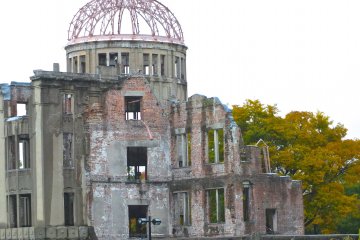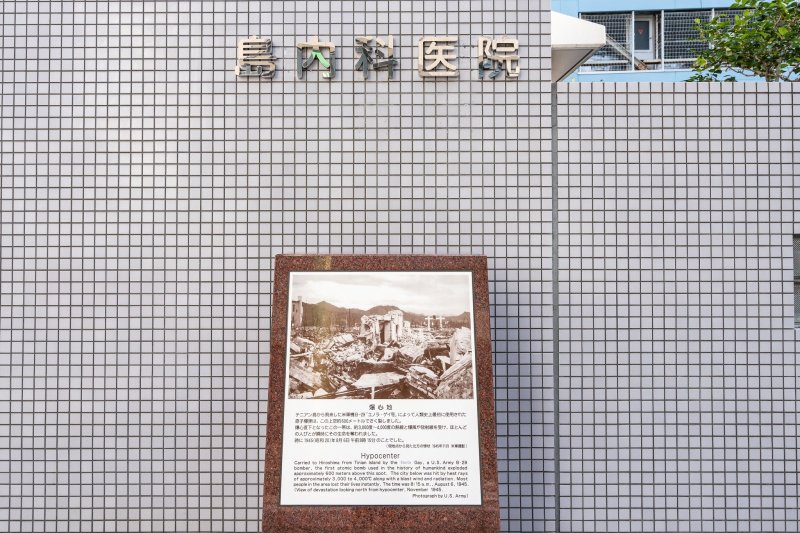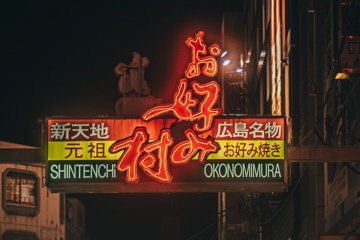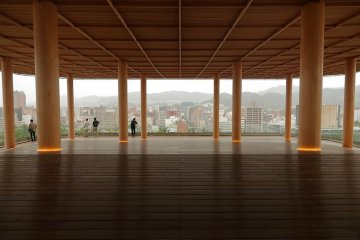

히로시마의 원자 폭탄 돔은 평화기념관 자체와 함께 세계 각지에서 온 방문객들이 찾는 평화의 상징이 되었습니다. 히로시마는 다시 한번 아름다운 도시가 되었고, 돔은 그 도시의 사람들이 회복할 수 있다는 의지를 보여줍니다. 현대적 고층빌딩들에 외로이 둘러 싸여 있지만, 어떻게든 평화를 위해 서있다는 것은 놀라운 일입니다. 11월 말, 전 수학여행에서 수백명의 어린 학생들과 함께 비가 오는 날에 이 돔에 갔습니다. 비 덕분에 뭔가 더 생동감 있게 느껴졌습니다.


히로시마의 유명한 돔 (체코 건축가 Jan Letzel의 디자인)은 그라운드 제로에서 160m 남동쪽에 있었습니다. 그러나 돔은 기적적으로 살아 남았습니다.



"Carried to Hiroshima from Tinian Island by the Enola Gay, a U.S. Army B-29 bomber, the first atomic bomb used in the history of humankind, exploded approximately 580 meters above this spot. T...

Okonomimura is a Hiroshima-style okonomiyaki theme park located in Shintenchi, Naka-ku, Hiroshima, near the east end of the Hondori shopping street. It has 24 okonomiyaki restaurants, each with a slightly different style and one different selection of ingredients. Okonomiyaki began in the pre-war period as a dish called "Issen Yoshoku" ("" Western food for a dime ""), which was very popular with common people. It consisted of a flour paste cooked with onions, dried shrimp, and spices. After the war, other ingredients such as cabbage, eggs, seafood, buckwheat and wheat noodles were used to improve the diet in these tough times. This is how today's Hiroshima-style okonomiyaki came about. [Photo: Victor Lee / CC BY-NC-ND 2.0]

현의 자연미, 역사적인 절, 그리고 도시의 박물관과 조각품들을 탐험할 때, 히로시마의 음식 문화를 통해 여러분의 취향도 함께 여행해보는 것은 어떨까요?

히로시마 스타일의 오코노미야키를 드셔지 않으셨다면 제대로 히로시마에 갔다고 할 수 없다! 식당에 자리를 잡아 쇼를 관람하고 히로시마의 "소울 푸드"로 배를 채워보자!

With its beautiful skylines and active waterways, Oizuru Tower offers its visitors a way to see all of that activity—day or night—unobstructed by glass or rails. The wooden floors and ceilings give off a gentle warmth and the pillars that support the ceilings also provide beams of light. Instead of glass or railings, guests can feel the Hiroshima air wash over them thanks to the stainless-steel net fence. With unobstructed views of Hiroshima, including the Peace Memorial Park and the Atomic Bomb Dome (and even Mount Misen of Miyajima on clear days), the tower offers viewers a way to feel at one with the city. Hiroshima Oizuru Tower is also home to an assortment of shops and cafés. Visit the first floor to find that special souvenir of one of Hiroshima’s local products at Hito to Ki. You’ll also find Hiroshima-style okonomiyaki in Akushu Café—including unique wrap-style okonomiyaki. On the 12th floor, you can also fold your own origami crane and leave it on the Oizuru Wall with your well wishes for the future. From the 12th floor to the 1st floor, there is a slide “cool-cool-cool” that runs alongside the spiral staircase. Why not try sliding your way down twelve floors—or just a couple, as you can exit in between floors. While you take a walk inside, browse the original comic created by Shuho Sato—manga artist of “Umizaru” and “Say Hello to Black Jack”—the works inside Oizuru Tower reflect on the theme of peace. No matter what you decide to do, you’ll be delighted by the spaces and experiences that you can create. Discover the past, present, and future of Hiroshima while you gaze out at this bustling city.

Hiroshima Peace Memorial Museum, located in southern Hiroshima, sits across from the Atomic Bomb Dome in the Peace Memorial Park. The museum houses information about Hiroshima’s history before and after the atomic bombing during WWII and aims to educate visitors about the infamous event and after-effects. Through education, the museum seeks to spread awareness about the inhumane nature of nuclear weapons and ultimately ban them. Its message is powerful: No More Hiroshimas. The east building contains three floors with permanent and temporary exhibitions. The second floor outlines the history of Hiroshima, while the third floor focuses on the aftermath of the bombing with video testimonies from bomb survivors, as well as displays about the dangers of nuclear weapons. The exhibits reflect the brutal truth of the bombing and the thousands of people who were killed and affected mentally and physically by the painful aftermath. The permanent exhibits in the main building document the unimaginable horrors through items found after the bombing—a tricycle, a lunchbox, a school uniform—all once mundane objects whose meanings now tell of the instantaneous devastation of human actions. Photos line the walls, honestly displaying the aftermath. Despite the unfiltered displays of war, the museum never wavers from its core message of remembrance, education, and future peace.

Hondori (本通) is one of the main shopping districts in Hiroshima's bustling downtown area. This pedestrian arcade street (shotengai) is a shopper's paradise, lined with everything from clothing stores, trendy boutiques, cafes and restaurants, through to karaoke bars, gaming arcades, purikura parlours and anime shops. When it comes to shopping in Hiroshima, Hondori is a popular choice. As a covered walkway, shoppers can also feel protected from the elements allowing plenty of time to find the perfect souvenir come rain or shine. Hondori is perfectly placed in the heart of Hiroshima's downtown and an easy, worthwhile stop on any Hiroshima itinerary. The street stretches for over half a kilometer from Peace Park in the west (near Sunmall), to the PARCO department store to the east (in the direction of Nagarekawa). It's easy to explore Hondori in combination with other sightseeing spots. For food, try local brands like Andersen's Bakery, the famous Okonomimura just off the eastern side, the well-known The Shack Bar and Grill, (moved from its original Chuodori location) or just keep things simple at the Starbucks on the eastern side — a popular meeting spot for locals, alongside the nearby Alice Garden. When shopping in Hiroshima, you can come across some interesting local chains, like Fresta, Wants and Edion (formerly DeoDeo)—not to mention some interesting heritage. Hiroshima is not just the home for Mazda, but also where it began for another global brand: Uniqlo. Just a few blocks away from Hondori towards Fukuromachi you can stumble across the building where the original branch for 'Unique Clothing Warehouse' (as it was originally known) started back in 1984. It's now occupied by a different business (Chacott), but easy to find being right next door to Hiroshima's branch of Paul Smith. Hondori is reliably busy at all times of the day, with many shops and cafes open until late. For a rainy day excursion, you can continue your shopping journey underground too — the entrance to the Kamiyacho Shareo underground mall can be located at the Hondori Streetcar stop.